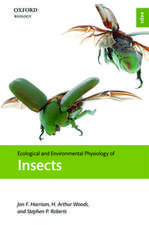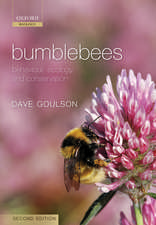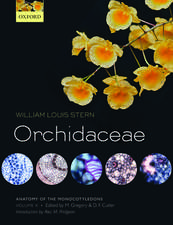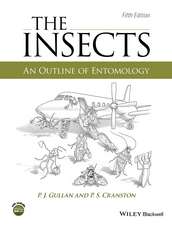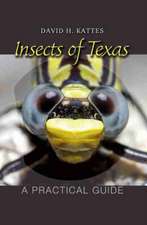Ant-Plant Interactions
Editat de Camilla R. Huxley, David F. Cutleren Limba Engleză Hardback – 15 aug 1991
Preț: 544.43 lei
Preț vechi: 813.27 lei
-33% Nou
Puncte Express: 817
Preț estimativ în valută:
104.17€ • 108.77$ • 86.22£
104.17€ • 108.77$ • 86.22£
Carte tipărită la comandă
Livrare economică 25-31 martie
Preluare comenzi: 021 569.72.76
Specificații
ISBN-13: 9780198546399
ISBN-10: 0198546394
Pagini: 620
Ilustrații: numerous halftones, line figures, and tables
Dimensiuni: 163 x 240 x 40 mm
Greutate: 1.09 kg
Editura: OUP OXFORD
Colecția OUP Oxford
Locul publicării:Oxford, United Kingdom
ISBN-10: 0198546394
Pagini: 620
Ilustrații: numerous halftones, line figures, and tables
Dimensiuni: 163 x 240 x 40 mm
Greutate: 1.09 kg
Editura: OUP OXFORD
Colecția OUP Oxford
Locul publicării:Oxford, United Kingdom
Cuprins
List of contributors; Camilla R. Huxley: Ants and plants: a diversity of interaction; Part 1: Antagonistic Interactions - The Leaf-Cutter Ants: D.J. Stradling: An introduction to the fungus-growing ants, Attini; R.J. Powell & D.J. Stradling: The selection and detoxification of plant material by fungus-growing ants; Jerome J. Howard: Resource quality and cost in the foraging of leaf-cutter ants; H.G. Fowler & Silvia Claver: Leaf-cutter ant assemblies: effects of latitude, vegetation, and behaviour; References to Part 1; Part 2: Ant-Plant Interactions Involving Herbivorous Insects: J.B. Whittaker: Effects of ants on temperate woodland trees; Rainer Rosengren & Liselotte Sundstrom: The interaction between red wood ants, Cinara aphids, and pines: a ghost of mutualism past?; J. Hall Cushman & John F. Addicott: Conditional interactions in ant-plant-herbivore mutualisms; Catherine M. Bristow: Why are so few aphids ant-tended?; S.G. Compton & H.G. Robertson: Effects of ant-homopteran systems on fig-figwasp interactions; N.E. Pierce, D.R. Nash, M. Baylis, & E.R. Carper: Variation in the attractiveness of lycaenid butterfly larvae to ants; P.J. DeVries: Evolutionary and ecological patterns in myrmecophilous riodinids; References to part 2; Part 3: Extrafloral Nectary-Mediated Interactions: Eugene W. Schupp & D.H. Feener, Jr.: Phylogeny, lifeform, and habitat dependence of ant-defended plants in a Panamanian forest; Paulo S. Oliveira & Carlos R.F. Brandao: The ant community associated with extrafloral nectaries in the Brazilian cerrados; Suzanne Koptur: Extrafloral nectaries of herbs and trees: modelling the interaction with ants and parasitoids; V.K. Rashbrook, S.G. Compton & J.H. Lawton: Bracken and ants: why is there no mutualism?; D.A. Mackay & M.A. Whalen: Some associations between ants and euphorbs in tropical Australasia; References to part 3; Part 4: Symbiosis Between Plants and Ants: Brigitte Fiala, Ulrich Maschwitz, & Tho Yow Pong: The association between Nacaranga trees and ants in South-east Asia; John T. Longino: Azteca ants in Cecropia trees: taxonomy, colony structure, and behaviour; Diane W. Davidson & Brian L. Fisher: Symbiosis of ants with Cecropia as a function of light regime; Doyle McKey: Phylogenetic analysis of the evolution of a mutualism: Leonardoxa (Caesalpiniaceae) and its associated ants; Philip S. Ward: Phylogenetic analysis of pseudomyrmecine ants associated with domatia-bearing plants; David H. Benzing: Myrmecotropy: origins, operation and importance; Matthew Jebb: Cavity structure and function in the tuberous epiphytic Rubiaceae; D.K. Letourneau: Parasitism of ant-plant mutualisms and the novel case of Piper; Pierre Jolivet: Ants, plants, and beetles; a triangular relationsip; References to part 4; Part 5: Pollination, Ant-Exclusion, and Dispersal: Rod Peakall, Steven N. Handel, & Andrew J. Beattie: The evidence for, and importance of, ant pollination; Ray Harley: The greasy pole syndrome; M. Westoby, L. Hughes, & B.L. Rice: Seed dispersal by ants: comparing infertile with fertile soils; W.J. Bond, R. Yeaton, & W.D. Stock: Myrmecocheory in Cape fynbos; Carol C. Horvitz: Light environments, stage-structure, and dispersal syndromes of Costa Rican Marantacaea; Seigo Higashhi & Fuminori Ito: Ground beetles and seed dispersal of the myrmecochorous plant Trillium tschonoskii (Liliaceae); Alan N. Andersen: Seed harvesting by ants in Australia; References to part 5; Part 6: Ants, Vegetation, and the Future of Ant-Plant Research: Stanley R.J. Woodell & Timothy J. King: The influence of mound-building ants on British lowland vegetation; John E. Tobin: A neotropical, rainforest canopy, ant community: some ecological considerations; Alan N. Andersen: Parallels between ants and plants: implications for community ecology; Andrew J. Beattie: Problems outstanding in ant-plant interaction research; Index to scientific names; Subject index.
Recenzii
'contains important reviews and research papers covering topics from leaf-cutter ants, ant-pollination, seed dispersal and extrafloral nectaries, to plants which provide a rest site and complete diet for symbiotic ants ... Also new techniques are described for the analysis of mutualistic co-evolution.'Ethology, Ecology & Evolution 4: 1992
'to any forester with an interest in and a basic knowledge of woodland ant biology several of the articles provide a fascinating insight into the latest developments in the field'W.H. Parry, Forestry, Vol. 65, No. 3, 1992
`It presents an impressive amount of information on most aspects of this prolific field of study and it will be a valuable benchmark source for this topic.^`The book has a uniform and authoritative feel to it for which the editors are to be congratulated. This is a conference volume but in the best tradition of that genre, and it is strongly recommended.'Annals of Botany
'to any forester with an interest in and a basic knowledge of woodland ant biology several of the articles provide a fascinating insight into the latest developments in the field'W.H. Parry, Forestry, Vol. 65, No. 3, 1992
`It presents an impressive amount of information on most aspects of this prolific field of study and it will be a valuable benchmark source for this topic.^`The book has a uniform and authoritative feel to it for which the editors are to be congratulated. This is a conference volume but in the best tradition of that genre, and it is strongly recommended.'Annals of Botany



